人教版(2019)必修 第二册Unit 1 Cultural Heritage Video time 课件(共26张PPT,内镶嵌2视频)
文档属性
| 名称 | 人教版(2019)必修 第二册Unit 1 Cultural Heritage Video time 课件(共26张PPT,内镶嵌2视频) |

|
|
| 格式 | pptx | ||
| 文件大小 | 52.0MB | ||
| 资源类型 | 教案 | ||
| 版本资源 | 人教版(2019) | ||
| 科目 | 英语 | ||
| 更新时间 | 2024-04-05 16:16:55 | ||
图片预览

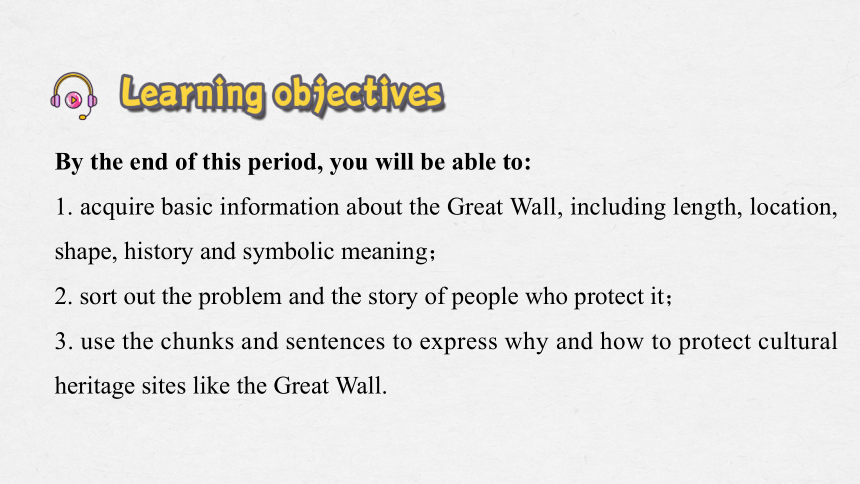
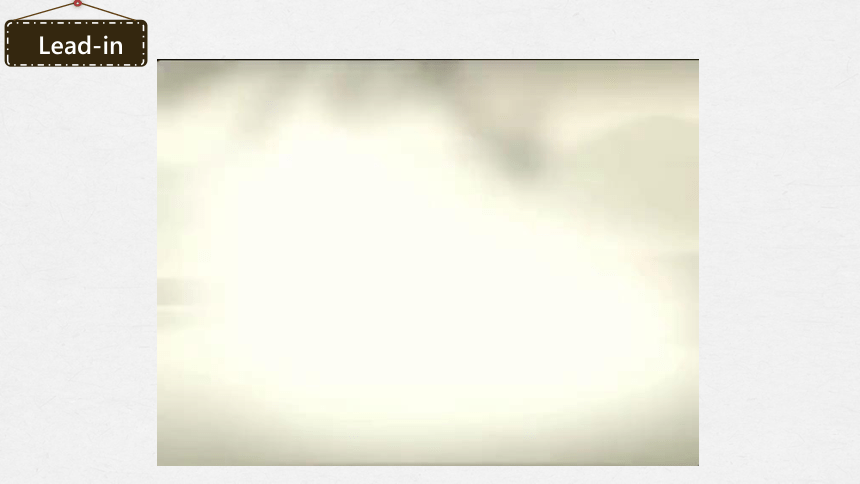
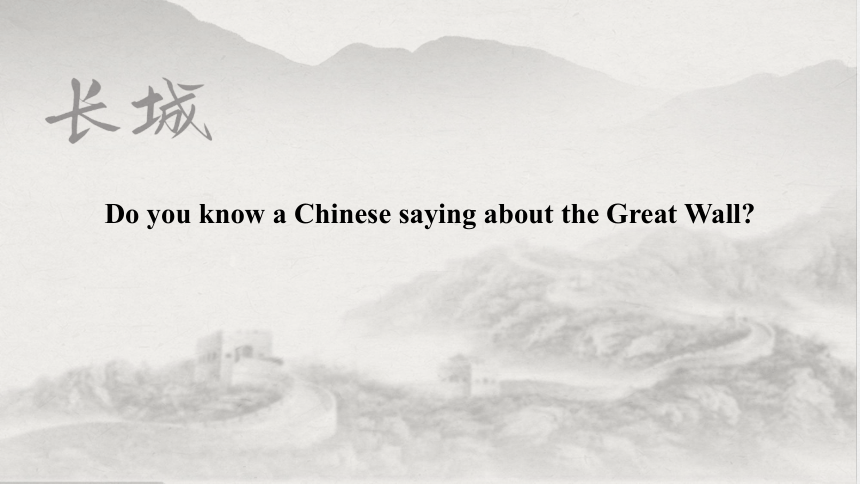
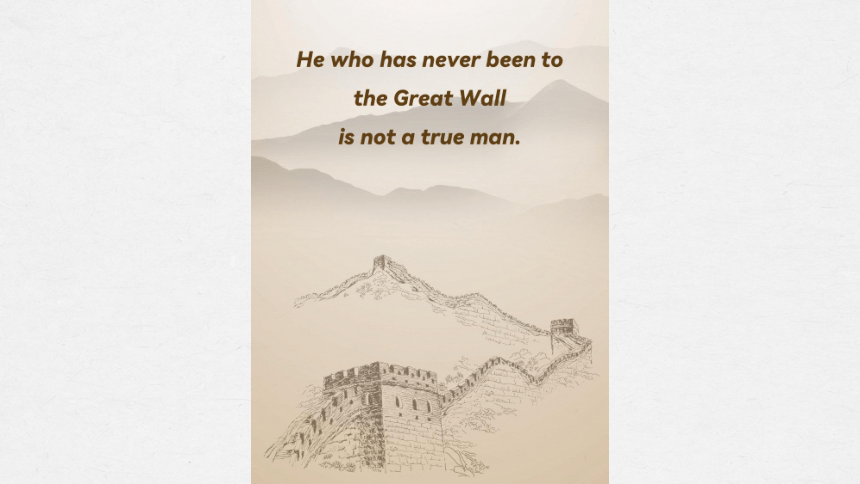

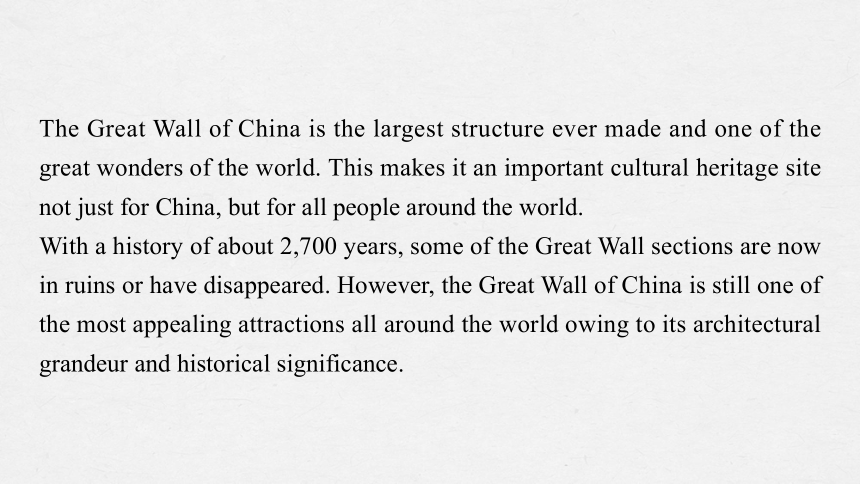
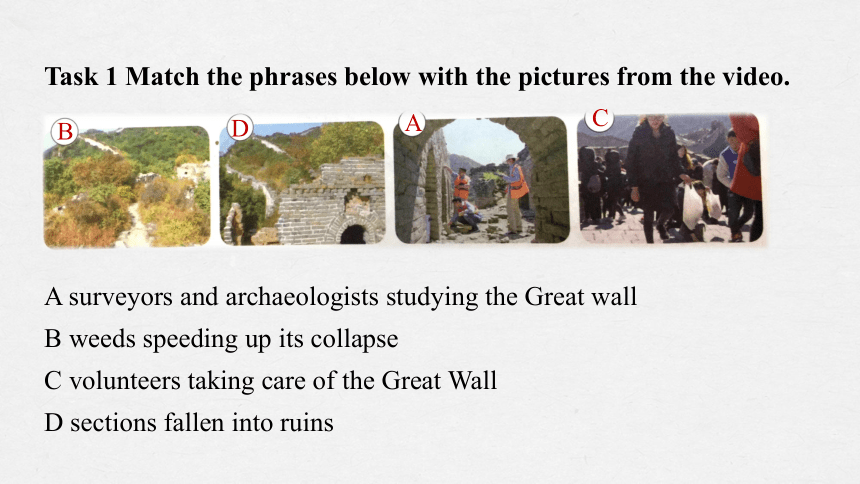
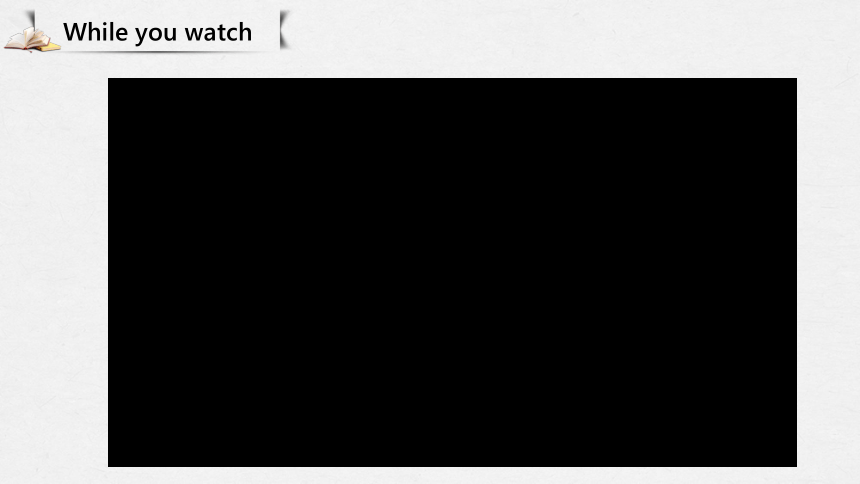
文档简介
(共26张PPT)
Cultural heritage
Unit 1
Video Time
By the end of this period, you will be able to:
1. acquire basic information about the Great Wall, including length, location, shape, history and symbolic meaning;
2. sort out the problem and the story of people who protect it;
3. use the chunks and sentences to express why and how to protect cultural heritage sites like the Great Wall.
Lead-in
Do you know a Chinese saying about the Great Wall
Before you watch
The Great Wall of China is the largest structure ever made and one of the great wonders of the world. This makes it an important cultural heritage site not just for China, but for all people around the world.
With a history of about 2,700 years, some of the Great Wall sections are now in ruins or have disappeared. However, the Great Wall of China is still one of the most appealing attractions all around the world owing to its architectural grandeur and historical significance.
Task 1 Match the phrases below with the pictures from the video.
A surveyors and archaeologists studying the Great wall
B weeds speeding up its collapse
C volunteers taking care of the Great Wall
D sections fallen into ruins
A
B
C
D
While you watch
B weeds speeding up its collapse
B
D
D sections fallen into ruins
A
A surveyors and archaeologists studying the Great wall
C
C volunteers taking care of the Great Wall
Task 2 Read the statements and decide whether they are true (T) or false (F).
1. Every part of the Great Wall is easy to find and see.
2. The Great Wall took 2,300 years to build.
3. Some of the Great Wall has been lost.
4. The length of the Great Wall is the same as the distance between the North and South Poles.
F
T
T
T
1. Every part of the Great Wall is easy to find and see.
F
2. The Great Wall took 2,300 years to build.
T
3. Some of the Great Wall has been lost.
T
4. The length of the Great Wall is the same as the distance between the North and South Poles.
T
Task 3 Complete the sentences below with the words you hear in the video.
1. We are __________ and we usually come here once a month.
2. But when we are not busy with school, we come here ___________________.
3. We hope more people will protect our _______________.
4. We need to protect the Great Wall, so we can present it to the future generations and let our cultural imprint ________.
volunteers
once every two weeks
cultural heritage
live on
Read together
Narrator:The Great Wall wines through vast mountains, sometimes visible, sometimes hidden. Once a great project that underwent 23 centuries of construction, many sections of it have now fallen into ruin or even disappeared without a trace, depending on when they were built.
Each section of the Great Wall records its transformation through the years and has incomparable historical value. This section of the wall is not far from the famous Badaling Great Wall. Mr Mei Jingtian has walked this six-kilometer mountain path for 30 years.
Weeds not only affect the wall’s image, but will also speed up its collapse, as their roots grow into the cracks in the bricks. These past 30 years, Mr. Mei Jingtian has been pulling weeds throughout this section of the Great Wall.
After six long years of hard work by surveyors and archaeologists, in 2012, the state Administration of Cultural Heritage in China announced the final data that the total length of the Great Wall of China is 21,196.18 kilometers. This is equivalent to the distance between the North and South Poles on the earth’s surface. This is clearly an astonishing figure, for it is four times longer than what has been described in the textbooks of China as the “Wanli Changcheng (10,000-Mile Long Wall) ” of the Qin dynasty.
Since 2006, Mr. Mei, together with surveyors and archaeological experts, has been measuring this section of the Great Wall. This, obviously, is a tough but fun task.
For the last 30 years, this ordinary elderly man has been taking care of the Great Wall in his own simple manner.
Visitor:Hi! How often do you come here
Volunteers:Hey!
Volunteers 1: We are volunteers and we usually come here once a month.
Volunteers 2: Yes, but when we are not busy with school, we come here once every two weeks.
Visitor:Thank you so much for what you’re doing. For all the international people like me this is a beautiful wall for all these years.
Volunteers 3: Oh, you are doing a great job!
Volunteers 4: Great!
Volunteers 3:Wonderful!
Volunteers 1: It is a different feeling each time we are here. We hope more people will protect our cultural heritage.
Volunteers 2: We need to protect the Great Wall, so that we can present it to the future generations and let our cultural imprint live on.
Narrator: With the participation of more volunteers, the area around the Great Wall has gradually become more natural and peaceful.
Each time we approach the Great Wall, without touching it, we can feel the memories and strong emotions from the ancient times.
After you watch
Discuss the questions.
1. Why is it important to protect cultural heritage sites like the Great Wall
It is important to protect cultural heritage sites such as the Great Wall because they are unique and can never be replaced. They are a link to our collective past and history, and can teach us a great deal…
2. Are there any important cultural heritage sites in your area
Yu Garden is an important cultural heritage site in my area. It dates from the Ming Dynasty. Although it suffered damage over centuries, today it is a popular destination. We can help protect it by making visitors respect its history. Tourism is good for sites like this, but we also shouldn’t allow too many people to visit at once as the site may get damaged…
Cultural heritage
Unit 1
Video Time
By the end of this period, you will be able to:
1. acquire basic information about the Great Wall, including length, location, shape, history and symbolic meaning;
2. sort out the problem and the story of people who protect it;
3. use the chunks and sentences to express why and how to protect cultural heritage sites like the Great Wall.
Lead-in
Do you know a Chinese saying about the Great Wall
Before you watch
The Great Wall of China is the largest structure ever made and one of the great wonders of the world. This makes it an important cultural heritage site not just for China, but for all people around the world.
With a history of about 2,700 years, some of the Great Wall sections are now in ruins or have disappeared. However, the Great Wall of China is still one of the most appealing attractions all around the world owing to its architectural grandeur and historical significance.
Task 1 Match the phrases below with the pictures from the video.
A surveyors and archaeologists studying the Great wall
B weeds speeding up its collapse
C volunteers taking care of the Great Wall
D sections fallen into ruins
A
B
C
D
While you watch
B weeds speeding up its collapse
B
D
D sections fallen into ruins
A
A surveyors and archaeologists studying the Great wall
C
C volunteers taking care of the Great Wall
Task 2 Read the statements and decide whether they are true (T) or false (F).
1. Every part of the Great Wall is easy to find and see.
2. The Great Wall took 2,300 years to build.
3. Some of the Great Wall has been lost.
4. The length of the Great Wall is the same as the distance between the North and South Poles.
F
T
T
T
1. Every part of the Great Wall is easy to find and see.
F
2. The Great Wall took 2,300 years to build.
T
3. Some of the Great Wall has been lost.
T
4. The length of the Great Wall is the same as the distance between the North and South Poles.
T
Task 3 Complete the sentences below with the words you hear in the video.
1. We are __________ and we usually come here once a month.
2. But when we are not busy with school, we come here ___________________.
3. We hope more people will protect our _______________.
4. We need to protect the Great Wall, so we can present it to the future generations and let our cultural imprint ________.
volunteers
once every two weeks
cultural heritage
live on
Read together
Narrator:The Great Wall wines through vast mountains, sometimes visible, sometimes hidden. Once a great project that underwent 23 centuries of construction, many sections of it have now fallen into ruin or even disappeared without a trace, depending on when they were built.
Each section of the Great Wall records its transformation through the years and has incomparable historical value. This section of the wall is not far from the famous Badaling Great Wall. Mr Mei Jingtian has walked this six-kilometer mountain path for 30 years.
Weeds not only affect the wall’s image, but will also speed up its collapse, as their roots grow into the cracks in the bricks. These past 30 years, Mr. Mei Jingtian has been pulling weeds throughout this section of the Great Wall.
After six long years of hard work by surveyors and archaeologists, in 2012, the state Administration of Cultural Heritage in China announced the final data that the total length of the Great Wall of China is 21,196.18 kilometers. This is equivalent to the distance between the North and South Poles on the earth’s surface. This is clearly an astonishing figure, for it is four times longer than what has been described in the textbooks of China as the “Wanli Changcheng (10,000-Mile Long Wall) ” of the Qin dynasty.
Since 2006, Mr. Mei, together with surveyors and archaeological experts, has been measuring this section of the Great Wall. This, obviously, is a tough but fun task.
For the last 30 years, this ordinary elderly man has been taking care of the Great Wall in his own simple manner.
Visitor:Hi! How often do you come here
Volunteers:Hey!
Volunteers 1: We are volunteers and we usually come here once a month.
Volunteers 2: Yes, but when we are not busy with school, we come here once every two weeks.
Visitor:Thank you so much for what you’re doing. For all the international people like me this is a beautiful wall for all these years.
Volunteers 3: Oh, you are doing a great job!
Volunteers 4: Great!
Volunteers 3:Wonderful!
Volunteers 1: It is a different feeling each time we are here. We hope more people will protect our cultural heritage.
Volunteers 2: We need to protect the Great Wall, so that we can present it to the future generations and let our cultural imprint live on.
Narrator: With the participation of more volunteers, the area around the Great Wall has gradually become more natural and peaceful.
Each time we approach the Great Wall, without touching it, we can feel the memories and strong emotions from the ancient times.
After you watch
Discuss the questions.
1. Why is it important to protect cultural heritage sites like the Great Wall
It is important to protect cultural heritage sites such as the Great Wall because they are unique and can never be replaced. They are a link to our collective past and history, and can teach us a great deal…
2. Are there any important cultural heritage sites in your area
Yu Garden is an important cultural heritage site in my area. It dates from the Ming Dynasty. Although it suffered damage over centuries, today it is a popular destination. We can help protect it by making visitors respect its history. Tourism is good for sites like this, but we also shouldn’t allow too many people to visit at once as the site may get damaged…
